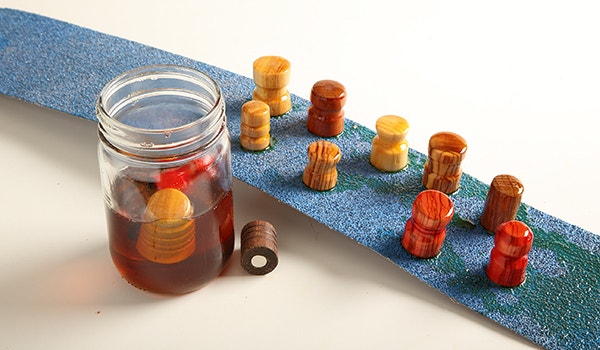Best Finish for Buttons and Pins
I make shawl pins, buttons and various other items linked to knitting, and I currently finish them all with several coats of wax. Do you think that I'm using the best finish or would you suggest something else? - Les Smith
Chris Marshall: If you like the look and feel of wax on these items, I don't see any reason to change the finish. Wax isn't a very durable choice, but it sounds like what you make really isn't subjected to much more than occasional light handling. For more durability, you could try a wiping varnish, thinned shellac or aerosol lacquer. They're all simple to apply, too. I don't think there's a "best" finish here. Go with what you like and what's convenient for you.
Tim Inman: You don't mention how you are making these items. If you are turning them on a lathe, then you might want to explore friction polishing, or French polishing. Although wax makes a nice look and feel, it isn't very durable. Shellac or fast-drying lacquers can be used to friction polish on a lathe. It is very easy to do. Have you considered tumbling? If you have very many of these items to polish, I'd suggest you look into this method of polishing and finishing small things. I have a crude, simple but effective tumbler that I made from a plastic 5-gallon bucket. It runs off a V-belt pulley I mount on my lathe; the bucket spins in a wooden cradle I made for the purpose. The belt circles around the bucket in a convenient "groove" which is molded into most common 5-gallon plastic buckets. Be sure to remove the wire bail if you try this.
To use it, I soak my small parts (wooden chess pieces, for me) in an oil/varnish/wax solution. Then, I drain them on a screen to get off all the excess. I put them into my tumbler bucket along with a generous supply of soft, clean flannel pieces. Layer them as you go - flannel, wood, flannel, wood, flannel. I don't fill the bucket more than 2/3 full. Snap on the lid, mount the bucket in the carriage, set up the belt, and turn it on. The "right" speed is pretty slow. Under no circumstances do you want the bucket going so fast the force stops the "tumbling" action inside. Let it run for several hours. Near the end, inspect. If everything is looking good, then I toss in a few pieces of beeswax, and tumble again for a couple more hours. When it is all done - and everything worked as planned - out come bright shinny pieces finished and polished all around, with very little time or effort expended on my part. It might take you a few tries to get things right, but it would be my best suggestion for you if you have lots of buttons and pins to do. Remember, oily cotton rags can be a fire hazard. Be sure to dispose of everything safely.
Keep the inspiration coming!
Subscribe to our newsletter for more woodworking tips and tricks




